- Homogeneous distribution and quantitative evaluation of sintering additives in spray-dried silicon nitride granules
Kati Raju, Tae-Gyeong Kim and Hyun-Kwuon Lee*
School of Advanced Materials Science and Engineering, Kumoh National Institute of Technology, Gumi-39177, South Korea
This article is an open access article distributed under the terms of the Creative Commons Attribution Non-Commercial License (http://creativecommons.org/licenses/by-nc/4.0) which permits unrestricted non-commercial use, distribution, and reproduction in any medium, provided the original work is properly cited.
Quantitative phase evaluation of sintering additives and their homogeneous distribution in ceramics are critical issues in ceramic processing. In the present work, we report the characteristics of silicon nitride granules containing sintering additives (Y2O3-Al2O3-Yb2O3) prepared by spray drying. For homogeneous mixing of sintering additives, using fine and similar particle sizes for all sintering additives is essential. In this study, the particle size was reduced by ball milling based on the particle size of the as-received sintering additive. Systematic studies using scanning electron microscopy and particle size analysis were conducted on starting materials and spray-dried granules. Highly stable aqueous slurries consisting of 25 vol.% of silicon nitride particles, 5 wt.% sintering additives, and 0.5 wt.% each of dispersant, binder, and plasticizer, were used in preparing the granules. Quantitative phase analysis and homogenous distribution of sintering additives in the granules were assessed by examining the mixing index values through Rietveld analysis of X-ray diffraction data and energy dispersive X-ray spectroscopy studies
Keywords: Ceramics, Silicon nitride, Microstructure, Spray drying, Granules
Silicon nitride (Si3N4) is one of the most attractive advanced ceramic materials used in many engineering applications due to its excellent properties [1, 2]. However, sintering Si3N4 is very difficult at relatively low temperatures; therefore, sintering additives are necessary in terms of densification. Accordingly, many sintering additives, including single- and multi-component Al2O3, Y2O3, and Yb2O3, have been evaluated as being more efficient [3-6].
Although several studies have reported the preparation of different Si3N4 materials with desired morphologies using different methods and various sintering additives, these studies have focused primarily on the processing methods [7-13]. Granule morphological silicon nitrides with controlled particle sizes have attracted considerable attention from various ceramic industries because of their ease of handling for numerous applications [14-17]. Spray drying is one of the most convenient ceramic-forming methods used in the granulation of ceramic materials. Spray drying is a simple and economically feasible method to produce ceramic granules [18-21].
However, studies on the fabrication of silicon nitride granules with sintering additives are limited [14, 17]. Some studies have been conducted, but research on the control of processing parameters for granule preparation, quantitative analysis, and evaluation of the homogenous distribution of sintering aids is lacking. Therefore, in the present study, we aimed to understand the characteristics of silicon nitride granules containing sintering additives (2.4 wt.% Y2O3 + 1.6 wt.% Al2O3 + 1 wt.% Yb2O3) prepared by spray drying.
Commercially available high-purity Si3N4 (E-10, Ube, Japan) was used as a raw material. High-purity Al2O3 (AES-11C, Sumitomo, Japan), Y2O3 (Wonik, South Korea), and Yb2O3 (Wonik, South Korea) were used as sintering additives. The average particle sizes of the as-received silicon nitride, alumina, yttria, and ytterbium powders were approximately 0.9, 0.73, 0.67, and 3.18 μm, respectively. To maintain similar fine and micron-sized particles of all sintering additives for better mixing, ytterbium oxide was ball-milled to reduce the particle size to approximately 0.68 μm. The as-received silicon nitride, alumina, yttria, and reduced ytterbium oxide powders were thoroughly ball-milled for 12 h using 5-mm Si3N4 balls after adding 0.5 wt.% ammonium polymethacrylate (Darvan C, R.T. Vanderbilt Co. Inc., USA) as a dispersant, polyethylene glycol (PEG400, Daejung Chemicals, South Korea) as a plasticizer, and polyvinyl alcohol (PVA 205, Daejung Chemicals, South Korea) as a binder in deionized water to each material to ensure homogeneous mixing of all phases in the slurry. A solid loading of 25 vol.% was used in the slurry. Sintering additives of 5 wt.% in the ratio of 2.4 wt.% Y2O3 + 1.6 wt.% Al2O3 + 1 wt.% Yb2O3 were added. After ball milling, the stability of the slurry was assessed by examining the zeta potential behavior using a zeta potential analyzer (ELSZ-200, Otsuka, Japan). The sedimentation behavior was also examined. The surface areas of the ball-milled powders after drying were determined using a BET analyzer (BELSORP-max, Japan). After degassing, the highly stable slurry was spray-dried using a spray drier (EYELA, SD-1000). The operating conditions of the spray drier are presented in Table 1. To prevent sedimentation, the slurries were mixed rigorously throughout the spray-drying period. The particle sizes of the raw powders, ball-milled powders, and granules were investigated using a laser diffraction particle size analyzer (PSA, Mastersizer 2000, Malvern, England). X-ray diffraction (XRD, SWXD(D-MAX/2500-PC), Rigaku, Japan) was performed in a range of 10°-70° 2q to analyze the phase purity and crystal structures at room temperature. The Fullprof program was used for Rietveld analysis of the XRD data [22]. The micro- structures were characterized and energy-dispersive X-ray spectroscopy elemental mapping studies of the granules were conducted using scanning electron microscopy (SEM, JSM-6500F, JEOL, Japan).
Fig. 1 shows SEM micrographs of the as-received Y2O3, Al2O3, and ball-milled Yb2O3 sintering additives used in this study. The SEM micrograph of the as-received silicon nitride raw powder is also compared in Fig. 1. For homogeneous mixing of sintering additives in silicon nitride granules, using similar particle sizes for all sintering additives is essential. Because in this study the particle sizes of the as-received sintering additives were different, ball milling was performed based on the sizes of the particles. Irregular particle sizes of sintering additives may lead to inhomogeneous mixing; therefore, Yb2O3 was initially milled to reduce the particle size. Fig. 1 shows that all powders exhibited similar particle sizes of approximately 1 μm. These results were corroborated by the PSA graphs shown in Fig. 1(e). After the powders containing silicon nitride and sintering additives were ball-milled for 12 h, the powders achieved an average particle size of approxi- mately 0.62 μm, as indicated by their PSA behaviors (Fig. 2), and a high surface area of 11.5 m2/g, as evidenced by BET analysis. Subsequently, the stability of the aqueous slurries containing sintering additives and silicon nitride powders was evaluated. For this purpose, a dispersant, binder, and plasticizer were added, and both zeta potential and sedimentation studies were performed. Zeta potential measurements indicated a high value of -40 mV at pH 9, and sedimentation results indicated that the slurries were highly stable for at least 48 h at this pH, as shown in Fig. 3.
After the slurry containing sintering additives and silicon nitride powders was prepared under optimal conditions, a spray dryer was used to produce granules with average particle sizes of approximately D50 27.4 μm, as evidenced by the PSA graph (Fig. 4). Typical SEM images of Si3N4 granules at different magnifications, along with their elemental mappings, are presented in Fig. 5. The images show that the granules were dense and exhibited circular shapes with an average size of approximately 30 μm. The homogeneous distribution of Si, Y, Al, and Yb could also be observed from the EDS elemental mapping analytical images, which indicated that all the sintering additives were distributed homogeneously in the granules. Quantitative analysis was performed by evaluating the degree of mixing index for granules using the following goodness-of-fit method, where Eq. (1) considers the wt.% of metallic elements from EDS data.

Here, Oi is the ith observed value (experimental) and Ei is the ith expected value (theoretical). EDS data was analyzed by considering a minimum of 30 data locations (on at least 10 granules three times each). The results indicated a good mixing index value of approximately 0.1.
To investigate the crystal structures and evaluate quantitatively the different phases present in the granules, Rietveld refinement was performed for the XRD data using the Fullprof method. Rietveld refinement is a powerful and convenient technique used for quantitative phase analysis that relies on the intensities of XRD data. Fig. 6 presents the Rietveld refinement analysis of the granules. The XRD data clearly show the presence of peaks only for the anticipated Si3N4, Y2O3, Al2O3, and Yb2O3 phases. No impurity peaks were detected. Fig. 6 also shows good agreement between the XRD patterns of the observed and calculated data. The difference data, along with Bragg’s positions for all the phases, are also presented in the figure. All quality factors obtained in this study were found to be very low (Rp = 1.62, Rwp = 2.06, and Rexp = 0.95), indicating reliable fitting. The quantitative weight fractions (wt.%) from Rietveld analysis for the Si3N4, Y2O3, Al2O3, and Yb2O3 phases were found to be 95.17%, 2.35%, 1.56%, and 0.92%, respectively. These values were in good agreement with the initial amounts of added powders. A good mixing index value of less than 0.09 was achieved from the goodness-of-fit analysis from (1), which corroborated the EDS data. The average Rietveld analysis of five samples of wt.% data was considered for the mixing index evaluation.
Based on the above results, it can be concluded that other required ceramic granules could be easily fabricated industrially at larger scale in a similar way. Although several studies have reported the preparation of different Si3N4 materials with desired morphologies using different methods and various sintering additives, these studies have focused primarily on the processing methods [7-14]. However, studies on the fabrication of silicon nitride granules with sintering additives are limited. Some studies have been conducted, but research on the control of processing parameters for granule preparation, quantitative analysis, and evaluation of the homogenous distribution of sintering aids is lacking. The present study aimed at the quantitative phase evaluation of sintering additives and their homogeneous distribution, which are critical issues in ceramic pro- cessing. To achieve homogeneous mixing of sintering additives in granules, using fine and similar particle sizes for all sintering additives is essential. In this study, the particle size was reduced by ball milling based on the particle sizes of the starting powders. Quantitative phase analysis and homogenous distribution of sintering additives in the granules were assessed by examining the mixing index values through Rietveld analysis of X-ray diffraction data and energy dispersive X-ray spectroscopy studies. Results indicated good mixing of the sintering additives. To investigate the crystal structures and evaluate quantitatively the different phases present in the granules, Rietveld refinement was performed for the XRD data using the Fullprof method. Because in this study the particle sizes of the as-received sintering additives were different, ball milling was performed based on the sizes of the particles. Irregular particle sizes of sintering additives may lead to inhomogeneous mixing.
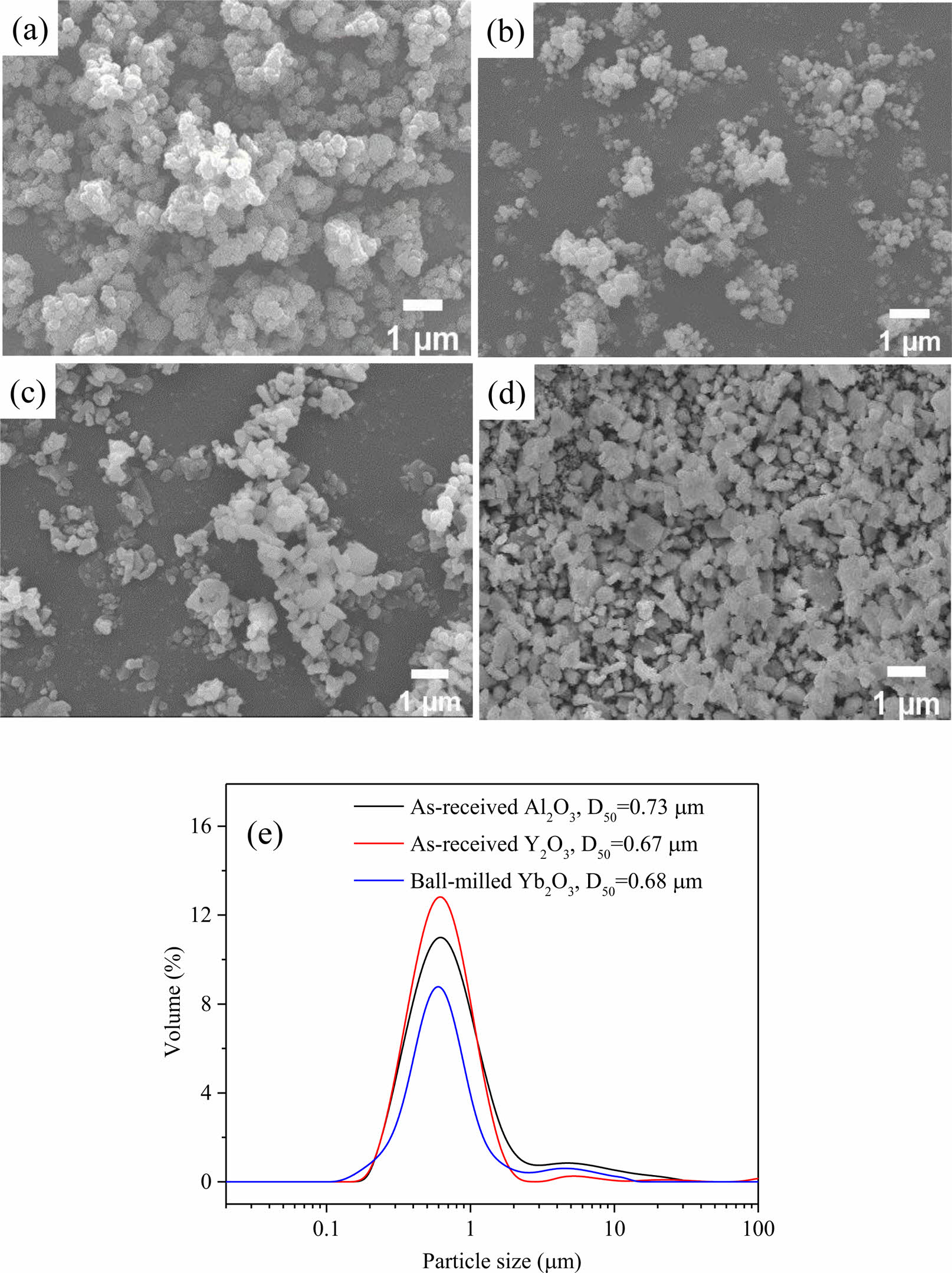
|
Fig. 1 SEM micrographs of as-received (a) Si3N4, (b) Y2O3, (c) Al2O3, and (d) ball-milled Yb2O3 powders, (e) PSA graphs of sintering additives. |
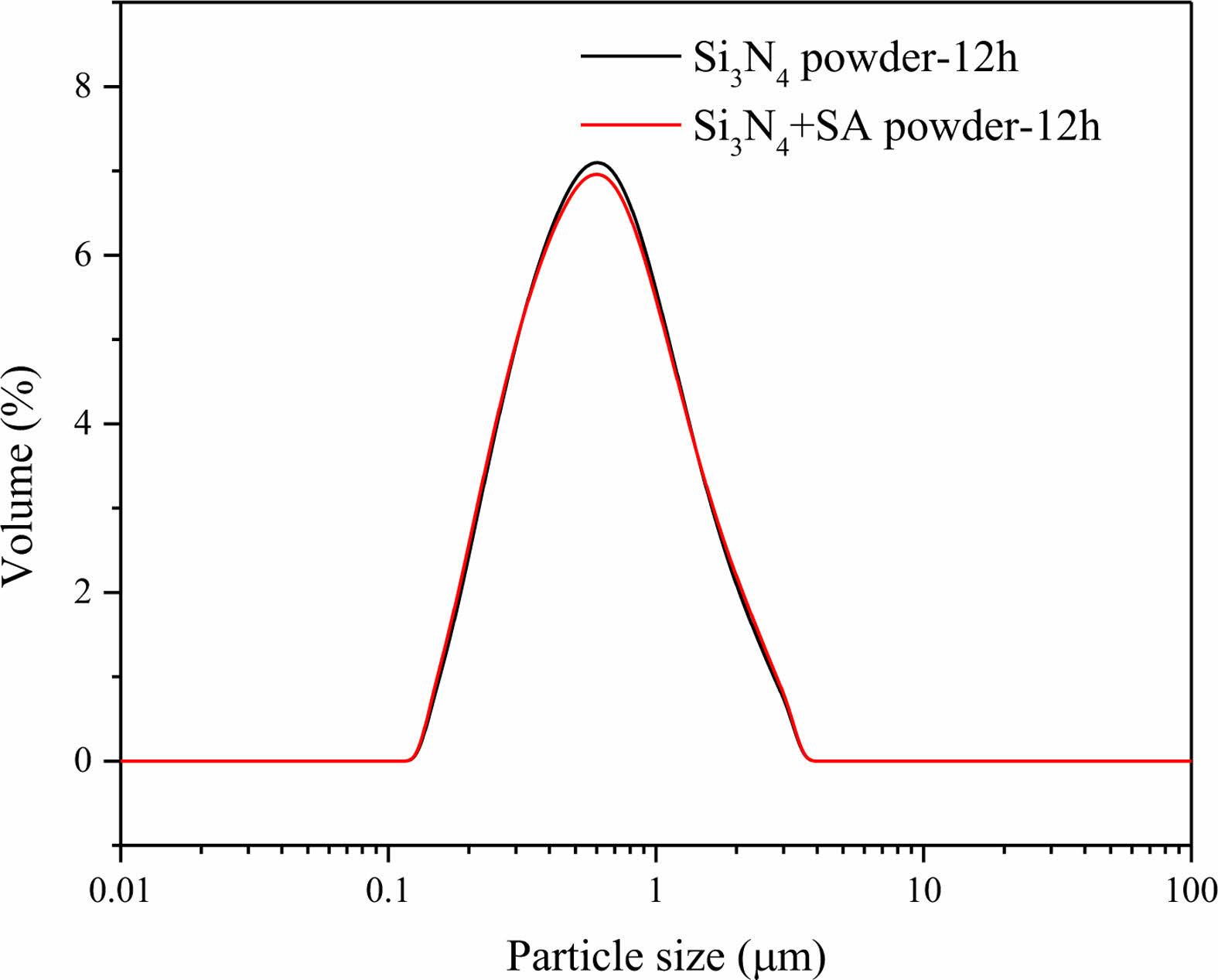
|
Fig. 2 Comparison of PSA behaviors of Si3N4 powders with and without sintering additives (SA). |
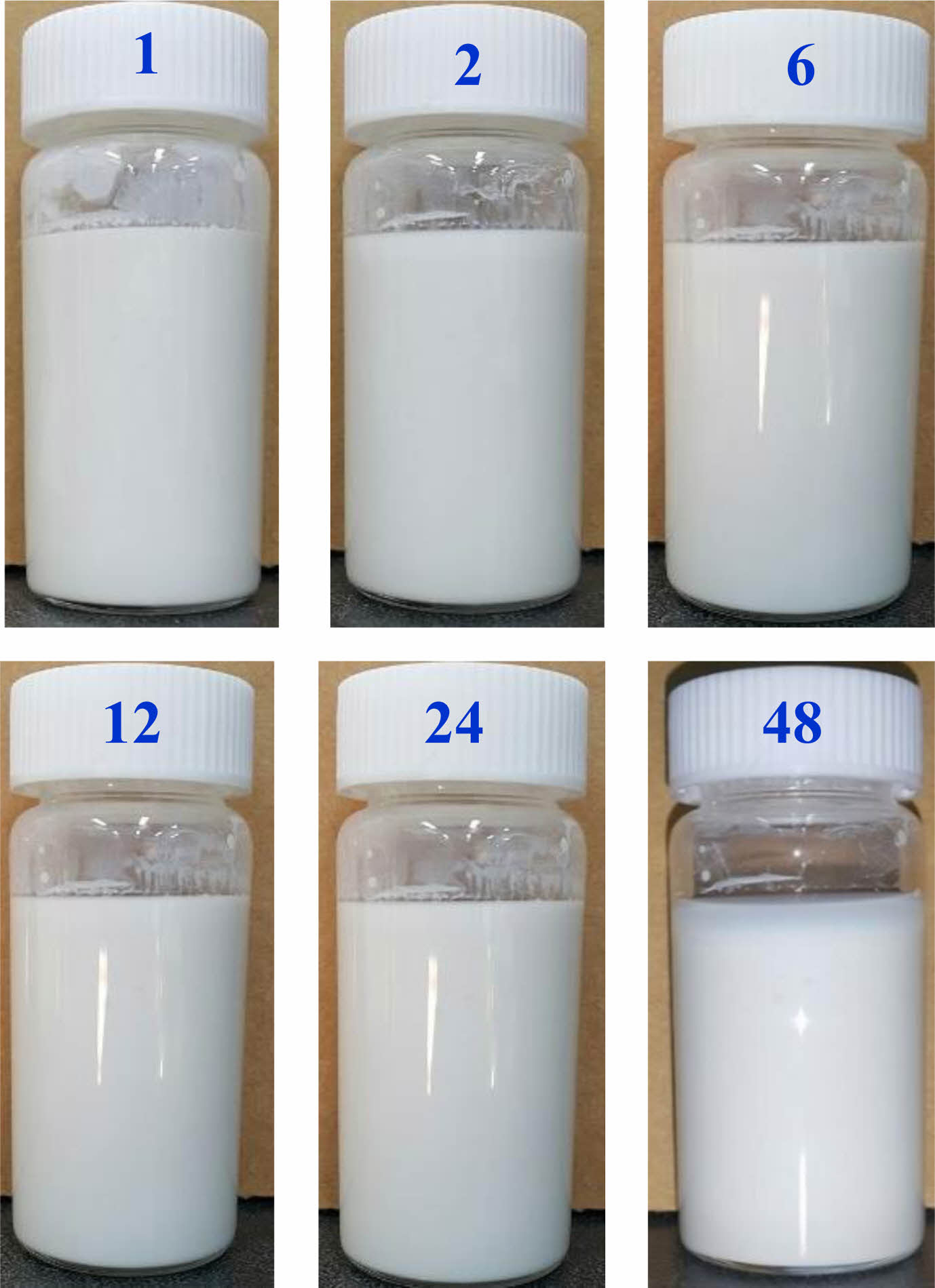
|
Fig. 3 Digital camera images of sedimentation behaviors of slurries after ball-milling for 12 h. |
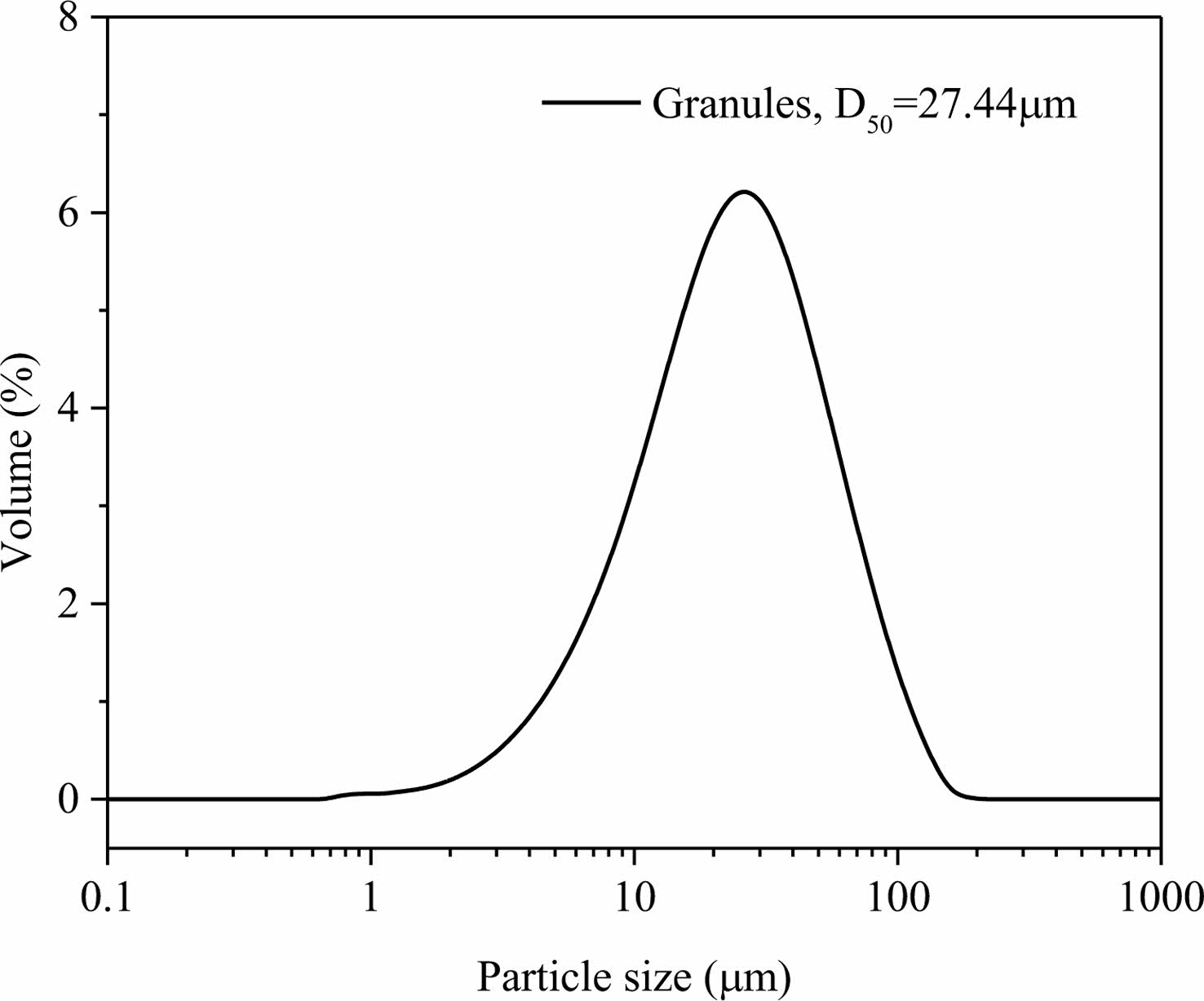
|
Fig. 4 Typical PSA behavior of Si3N4 granules |
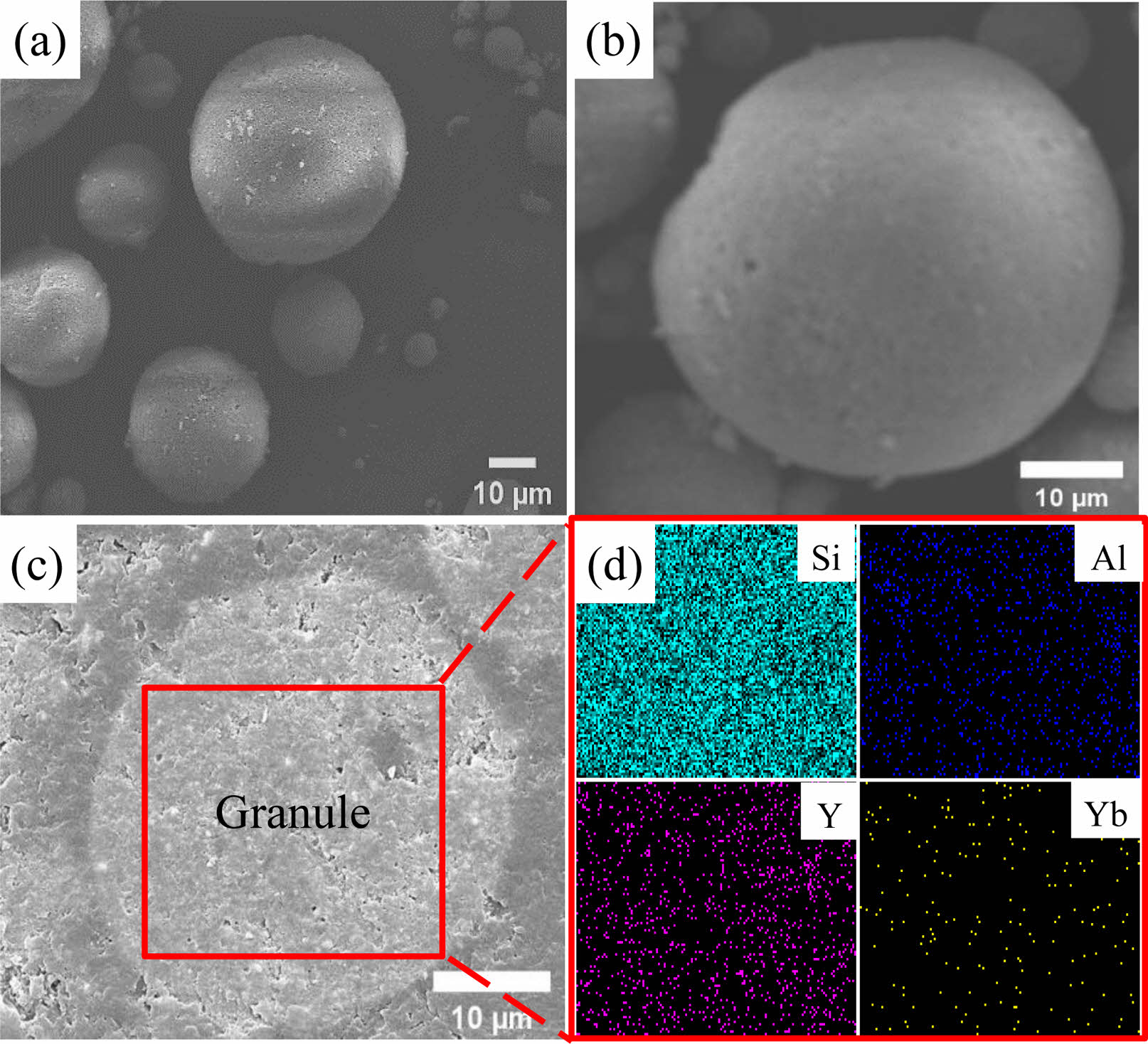
|
Fig. 5 SEM micrographs of spray-dried Si3N4 granules at different magnifications and its elemental mapping. |
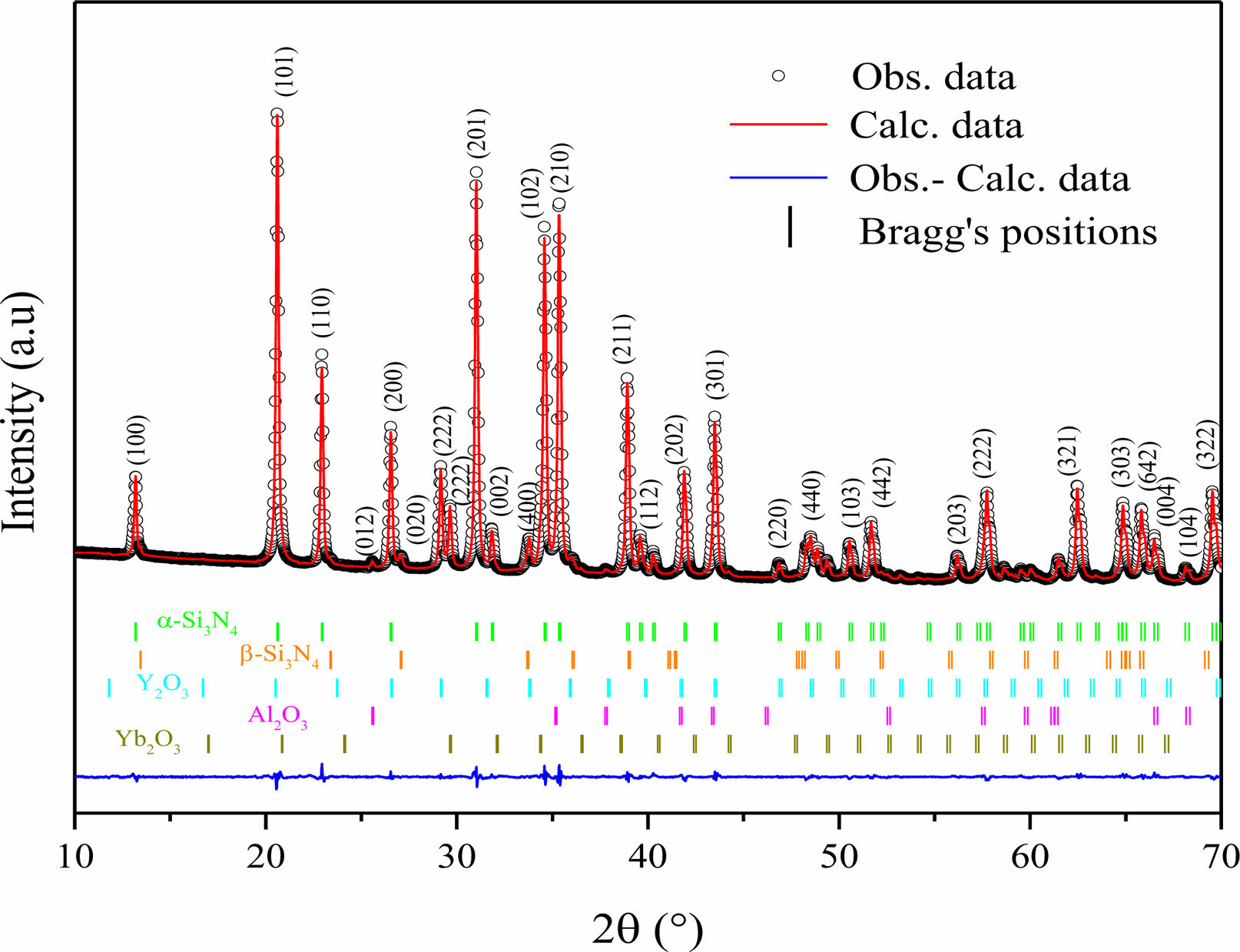
|
Fig. 6 Typical Rietveld analysis of Si3N4 granules containing sintering additives. |
To achieve homogeneous mixing of sintering additives in granules, using fine and similar particle sizes for all sintering additives is essential. In this study, the particle size was reduced by ball milling based on the particle sizes of the starting powders. Silicon nitride granules were prepared using highly stable aqueous slurries consisting of 25 vol.% of silicon nitride particles, 5 wt.% sintering additives, and 0.5 wt.% each of dispersant, binder, and plasticizer. Quantitative phase analysis and homogenous distribution of sintering additives in the granules were assessed by examining the mixing index values through Rietveld analysis of X-ray diffraction data and energy dispersive X-ray spectroscopy studies. Results indicated good mixing of the sintering additives. Based on the results, it can be concluded that other required ceramic granules could be fabricated industrially at larger scale using the similar processing technique. Further studies on the effects of various sintering conditions on the prepared silicon nitride granules are necessary, which are in progress.
This work was partially supported by the Ministry of Trade, Industry, and Energy (MOTIE) and Korea Evaluation Institute of Industrial Technology (KEIT) research funding (Grant No. 20000343).
The authors declare no competing financial interest.
- 1. F.L. Riley, J. Am. Ceram. Soc. 83 (2000) 245-265.
-

- 2. H. Klemm, J. Am. Ceram. Soc. 93 (2010) 1501-1522.
-

- 3. H. Park, H.-E. Kim, and K. Niihara, J. Am. Ceram. Soc. 80 (1997) 750-756.
-

- 4. T. Honma and Y. Ukyo, J. Mater. Sci. Lett. 18 (1999) 735-737.
-

- 5. L.C. Cardenas, J.L. Ruiz, D.J. Vigueras, and S.D. de la Torre, J. Alloys Compd. 501 (2010) 345-351.
-

- 6. W. Xu, Z. Yin, J. Yuan, Z. Wang, and Y. Fang, Mater. Sci. Eng. A 684 (2017) 127-134.
-

- 7. H. Takahashi, N. Shinohara, M. Okumiya, K. Uematsu, T. Junlchiro, Y. Iwamoto, and H. Kamiya, J. Am. Ceram. Soc. 78 (1995) 903-908.
-

- 8. B. Cecen, G. Topates, A. Kara, S.O. Akbulut, H. Havitcioglu, and L.D. Kozaci, Ceram. Int. 47 (2021) 3938-3945.
-

- 9. O.A. Lukianova and O.N. Ivanov, Ceram. Int. 44 (2018) 390-393.
-

- 10. Q. Yang, Z. Chen, X. Yang, D. Zhou, X. Qian, J. Zhang, and D. Zhang, Mater. Lett. 212 (2018) 41-44.
-

- 11. Y. Zhang, D. Yao, K. Zuo, Y. Xia, J. Yin, H. Liang, and Y.-P. Zeng, Mater. Lett. 276 (2020) 128264.
-

- 12. M. Vaseghi, S. Baghshahi, M. Masshhadi, and A. Nemati, J. Ceram. Process. Res. 20 (2019) 512-517.
-

- 13. S.-H. Ahn and K.-W. Nam, J. Ceram. Process. Res. 22 (2021) 54-60.
-

- 14. T. Hotta, K. Nakahira, M. Naito, N. Shinohara, M. Okumiya, and K. Uematsu, J. Eur. Ceram. Soc. 21 (2001) 603-610.
-

- 15. A. Meurk, J. Yanez, and L. Bergstrom, Powder. Tech. 119 (2001) 241-249.
-

- 16. S.-Y. Sun, Z.-P. Xie, and K.-E. Chen, Ceram. Int. 46 (2020) 10879-10884.
-

- 17. K. Wang, C. Bao, C. Zhang, Y. Li, R. Liu, H. Xu, H. Ma, J. Man, and S. Song, Ceram. Int. 47 (2021) 31277-31285.
-

- 18. A. S. Zujeva, Z. Irbe, and L.B. Cimdina, Ceram. Int. 43 (2017) 11543-11551.
-

- 19. O. Yildiz and A.M. Soydan, Ceram. Int. 4 (2019) 17521-17528.
-

- 20. H.K. Chahal, S. Matthews, and M.I. Jones, Ceram. Int. 47 (2021) 351-360.
-

- 21. O. Tungalagtamir, Y.-S. Park, J. Lee, S.D. Johnson, D.-S. Park, and C. Park, J. Ceram. Process. Res. 21 (2020) 571-578.
-

- 22. J.R. Carvajal, Full Prof Suite, Laboratoire Leon Brillouin (CEA-CNRS), France, 2006.
 This Article
This Article
-
2023; 24(2): 211-215
Published on Apr 30, 2023
- 10.36410/jcpr.2023.24.2.211
- Received on Jul 5, 2022
- Revised on Oct 6, 2022
- Accepted on Nov 3, 2022
 Services
Services
- Abstract
introduction
materials and methods
results and discussion
conclusions
- Acknowledgements
- Conflict of Interest
- References
- Full Text PDF
Shared
 Correspondence to
Correspondence to
- Hyun-Kwuon Lee
-
School of Advanced Materials Science and Engineering, Kumoh National Institute of Technology, Gumi-39177, South Korea
Tel : +82-544787745 Fax: +82-544787769 - E-mail: hklee@kumoh.ac.kr






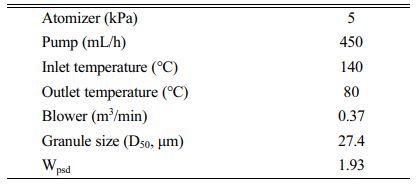
 Copyright 2019 International Orgranization for Ceramic Processing. All rights reserved.
Copyright 2019 International Orgranization for Ceramic Processing. All rights reserved.